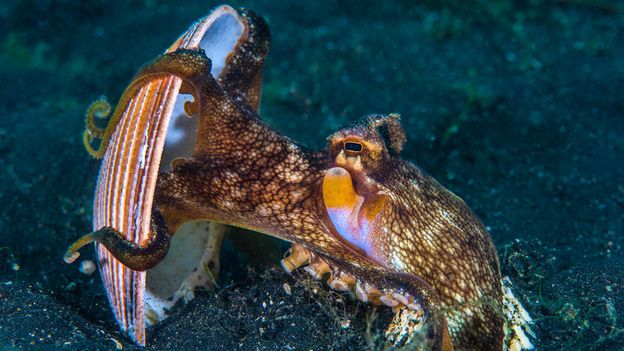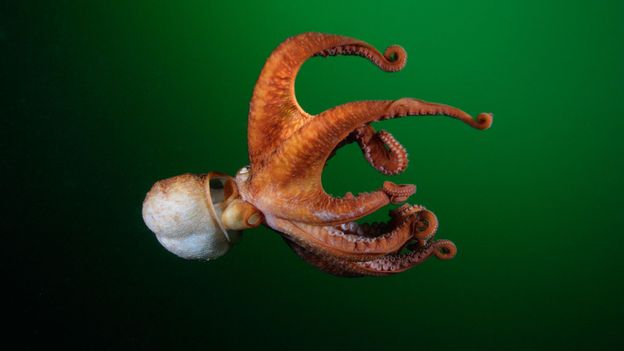A giant Pacific octopus (Enteroctopus dofleini) (Credit: Brandon Cole/naturepl.com)
Bend it like Inky
Play has often been seen as
the preserve of animals with higher cognitive abilities. It is hard to
precisely define it, but in broad terms play is activity that does not
serve an immediately useful function other than enjoyment.
After learning about the work of Lethbridge University colleague Sergio Pellis on mammalian play, Mather wondered whether octopuses play. Working with Seattle Aquarium biologist Roland Anderson, who died in 2014, she devised an experiment.
Roland phoned me and said 'he's bouncing the ball'
They placed eight giant Pacific octopuses
in bare tanks, and over 10 trials gave them floating plastic pill
bottles to investigate. At first the octopuses all put the bottles to
their mouths, apparently to see if they were edible, then discarded
them.
However, after several trials, two of them began blowing
jets of water at the bottles. The bottles were sent tumbling to the
other side of their aquarium, in such a way that the existing current
brought them back to the octopuses. The researchers, who published the study in 1999, argued that this was a form of exploratory play.
"Roland phoned me and said 'he's bouncing the ball'," says Mather.
She
says the octopuses were playing with the bottles. This is similar to
the way human children quickly start to play with unfamiliar objects,
something psychologist Corinne Hutt highlighted several decades ago.
"If
you have an octopus in any new situation, the first thing it does is it
explores," says Mather. "I think it was Hutt who said children will go
from 'what does this object do?' to 'what can I do with this object'.
That's what these octopuses were doing."
Temperamentally tentacled
Mather and Anderson
were happy to conclude that their octopuses were playing, even though
only a couple of them did so. That was because they had previously shown
that octopuses have personalities.
This means that individual
octopuses behave in consistent ways, which differ from their fellows.
This comes as no surprise to people who work with them. For example,
octopuses kept in aquaria are often given names, which relate to how
they respond to people.
Octopuses pass their personality traits onto their offspring
Mather and Anderson set out to measure these personality differences. They kept 44 East Pacific red octopuses
in tanks. Every other day for two weeks, a researcher opened their tank
lids and put their head close to the opening, touched the octopuses
with a test tube brush, and offered them tasty crabs.
The researchers recorded 19 different responses. In a study published in 1993, they identified significant and consistent differences between individuals. For example, some of the octopuses would usually respond passively, while others tended to be inquisitive.
"People
often talk about rainforests as complex environments, but the
near-shore coral reef is much more so," says Mather. "The octopus has
many potential predators and a huge array of potential food, and given
their varied and varying environments it makes a great deal of sense
that individuals do not fit precisely into the same niche."
In a follow-up study published in 2001, they found evidence that octopuses pass their personality traits onto their offspring. Given that they do not raise their young, this suggests their personalities are at least partly genetic.
Mather believes these variations in personality may underpin many of octopuses' advanced cognitive abilities, by allowing them to learn and adapt quickly.
It just shows that there are many other intelligent life forms that we share this planet with!
The blog song for today is: " Octopus´s Garden" by The Beatles. (of course)!!!
TTFN
Master of disguise
The evolutionary arms race
has led animals to develop many devious ways to fool each other. There
are grass snakes that play dead to avoid being eaten, male fish that
pretend to be female to boost their reproductive prospects, and birds
that feign broken wings to lure predators away from vulnerable
offspring.
When moving through open water, it mimics a lionfish
Yet of all of nature's charlatans, the mimic octopus must be a leading contender for the title of "master of disguise".
Other
octopuses can change the colour and texture of their skin to give
predators the slip. The mimic is the only octopus that has been observed
impersonating other animals. It can change its shape, movement and
behaviour to impersonate at least 15 different species.
When travelling across sand, it can flatten its arms against its body and undulate like a venomous banded sole. When moving through open water, it mimics a lionfish, which is also venomous. Another trick is to put six of its arms into a hole and use the remaining two to look like a banded sea krait, a type of sea snake that is, of course, venomous.
A problem solved
Octopuses can use trial and error to find the best way to get what they want.
They have different strategies to achieve the same ends
In work published in 2007, Mather and Anderson observed giant Pacific octopuses trying to get at the meat in different types of shellfish.
They simply broke open fragile mussels, pulled apart stronger Manila
clams, and used their tongue-like radulas to drill into very strong
littleneck clams.
When given a choice of the three, the octopuses
favoured the mussels, presumably because they required less effort to
get a meal.
The researchers then tried to confuse their subjects
by wiring Manila clams shut. However, the octopuses simply switched
technique. Mather concluded that they could learn based on non-visual
information.
"It told us that octopuses are problem-solvers," she
says. "They have different strategies to achieve the same ends, and they
will use whichever is easiest first."
Mazes for molluscs
During fieldwork in
Bermuda, Mather observed octopuses returning to their dens after hunting
trips without retracing their outgoing routes. They also visited
different parts of their ranges one after another on subsequent hunts
and days.
Most of the octopuses had learned to recognise which maze they were in.
In a study published in 1991, she concluded that octopuses have complex memory abilities. They can remember the values of known food locations, and information about places they have recently visited.
When
animals use landmarks to help them navigate, they have to be understand
the landmarks' relevance within their contexts. This ability, known as
conditional discrimination, has traditionally been seen as a form of
complex learning: something only backboned "vertebrates" can do.
In work published in 2007, Jean Boal of Millersville University in Pennsylvania placed California two-spot octopuses
in two different mazes. In each case they had to travel from the middle
of a brightly-lit tank to reach a dark den, an environment they
preferred. To get there they had to avoid a false burrow, which was
blocked by an upside-down glass jar.
After five trial runs, most
of the octopuses had learned to recognise which maze they were in and
immediately headed for the correct burrow. This, Boal concluded, meant octopuses do have conditional discrimination abilities.

A mimic octopus (Thaumoctopus mimicus) (Credit: Jeff Rotman/naturepl.com)
Similarly different
In many ways, octopuses' brains are rather like ours.
They
have folded lobes, similar to those of vertebrate brains, which are
thought to be a sign of complexity. What's more, the electrical patterns
they generate are similar to those of mammals.
The last common ancestor of humans and octopuses lived a long time ago
Octopuses also have monocular vision,
meaning they favour the vision from one eye over that from the other.
This trait tends to arise in species where the two halves of the brain
have different specialisations. It was originally considered uniquely
human, and is associated with higher cognitive skills such as language.
Octopuses even store memories in a similar way to humans. They use a process called long-term potentiation, which strengthens the links between brain cells.
These
similarities are startling. The last common ancestor of humans and
octopuses lived a long time ago, probably quite early in the history of
multicellular life, and was a simple animal. That means the similarities
in brain structure have evolved independently.
Even more fascinating than the similarities, however, are the differences.
Octopus intelligence may be distributed over a network of neurons, a little bit like the internet
More
than half of an octopus's 500 million nervous system cells are in their
arms. That means the eight limbs can either act on their own or in
coordination with each other.
Researchers who cut off an octopus's arm found that it recoiled when they pinched it, even after an hour detached from the rest of the octopus. Clearly, the arms can act independently to some extent.
While
the human brain can be seen as a central controller, octopus
intelligence may be distributed over a network of neurons, a little bit
like the internet.
If this is true, the insights octopuses offer
extend way beyond their advanced cognitive and escapology abilities.
Inky and his relatives may force us to think in a new way about the
nature of intelligence.












